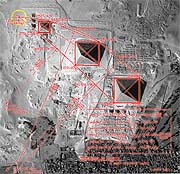- The vanishing point is
exactly
1000 cubits southwards from the theoretical axial line
that passes through the Sphinx.
- The two circles
intersect exactly
11000 cubits northwards from the centre of the large
circle.
- The large circle was
exactly 20 times the
diameter of the small circle.
- The small circle circumference is also just
10 times
the distance northwards from the centre of the
circle to the Vanishing Point.
- The above dimension is just 25
times the base-side of the Great Pyramid of 440 cubits.
-
The
intersection is ten times the initial dimension of
1100 cubits from the north side of the Great Pyramid to
the south side of the Second Pyramid.
-
The
centre of the large circle is also 13060 cubits
south from the north side of the Great Pyramid, and
12620 cubits southwards from the south side of the Great
Pyramid; the former being exactly 20 times the east-west
distance of 653 cubits between the east sides of the
Second and Great Pyramids, while the latter is just 20
times the north-south distance of 631 cubits between the
south sides of the Second and Third Pyramids.
-
The
smaller circle radius is 2742 cubits and its centre
is 2740.27 cubits east from the vanishing point, these
dimensions being about ten times the height of the
Second Pyramid of 274 cubits.
- The builders used multiples of
10,000 cubits for
Large measurements.
- These large scale measurements
express the
'classic' value for pi of 22/7
- The Vanishing point rests exactly
on a bowed wall, a wall that describes a
third circle,
with a radius of 4800 cubits.
* Calculations
are made by John Legon, based upon
Flinders Petrie's survey |


